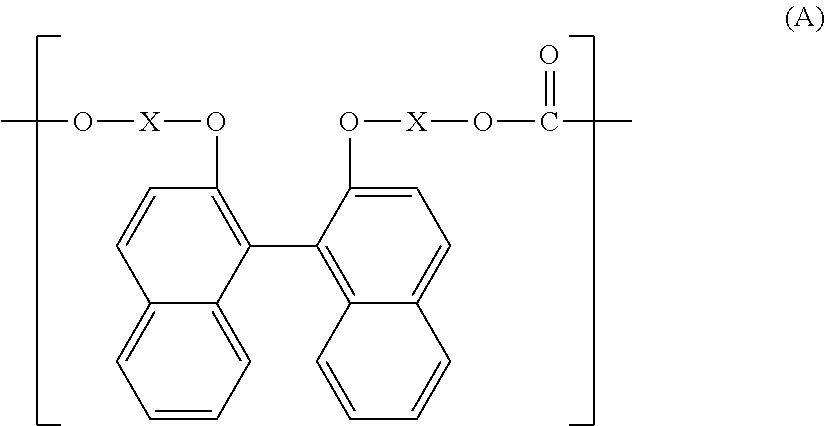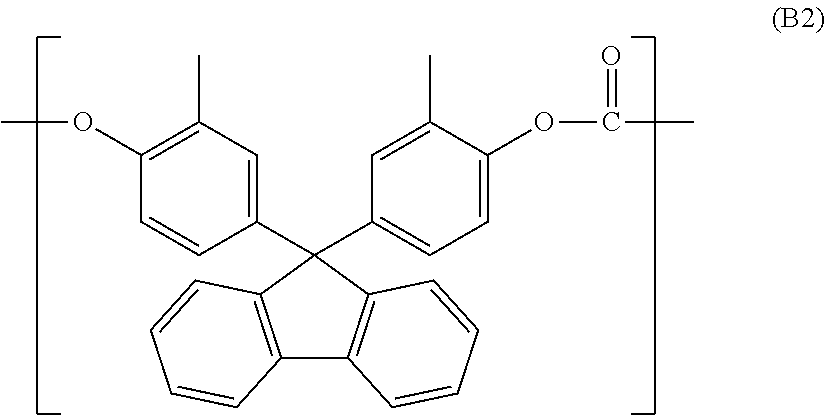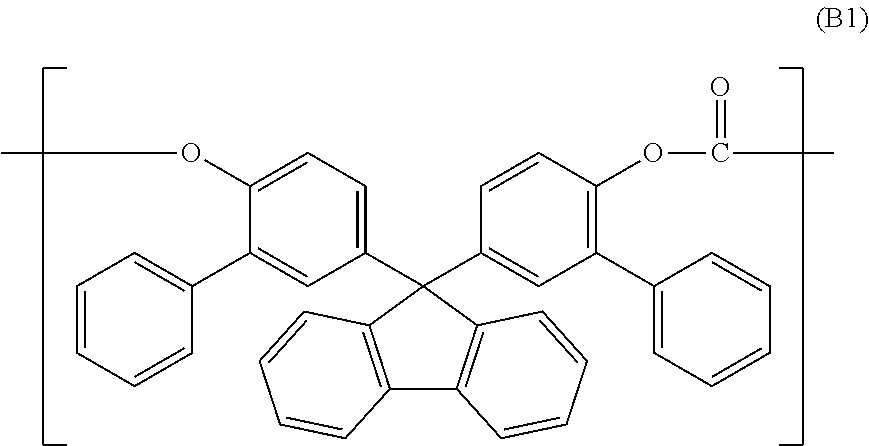Polycarbonate resin, production method therefor, and optical molded body
a technology of polycarbonate resin and production method, applied in the field of polycarbonate resin, can solve the problems of poor molding processability, high material cost, low productivity, etc., and achieve the effects of low abbe's number, high degree of transparency, and high refractive index
- Summary
- Abstract
- Description
- Claims
- Application Information
AI Technical Summary
Benefits of technology
Problems solved by technology
Method used
Image
Examples
first embodiment
[0045]The first embodiment includes the following inventions, by way of example.
[1]A polycarbonate resin having a structural unit represented by general formula (A):
(in formula (A), X is an alkylene group having 1 to 4 carbon atoms).
[2] The polycarbonate resin according to [1], consisting only of the structural unit represented by general formula (A).
[3] The polycarbonate resin according to [1] or [2], wherein the resin has a weight average molecular weight Mw of 20000 to 200000.
[4] An optical molded article, comprising the polycarbonate resin according to any one of [1] to [3].
[5] An optical lens, comprising the polycarbonate resin according to any one of [1] to [3].
[6] An optical film, comprising the polycarbonate resin according to any one of [1] to [3].
[7]A method for preparing the polycarbonate resin according to any one of [1] to [3], wherein a compound represented by general formula (I) is used as a starting material:
(in formula (I), X is an alkylene group having 1 to 4 carbo...
second embodiment
[0137]The second embodiment includes the following inventions, by way of example.
[1]A polycarbonate resin copolymer containing structural units represented by general formula (A) and general formula (B):
(in formula (A), X is an alkylene group having 1 to 4 carbon atoms), and
(in formula (B), R1 and R2 are each independently a hydrogen atom, an alkyl group having 1 to 20 carbon atoms, an alkoxyl group having 1 to 20 carbon atoms, a cycloalkyl group having 5 to 20 carbon atoms, a cycloalkoxyl group having 5 to 20 carbon atoms, an aryl group having 6 to 20 carbon atoms or an aryloxy group having 6 to 20 carbon atoms).
[2] The polycarbonate resin copolymer according to [1], wherein the molar ratio (A / B) between the structural unit (A) and the structural unit (B) is in the range of 20 / 80 to 99 / 1.
[3] The polycarbonate resin copolymer according to [1] or [2], wherein the structural unit (A) is a structural unit (A1) represented by the following formula:
[4] The polycarbonate resin copolymer a...
third embodiment
[0225]The third embodiment includes the following inventions, by way of example.
[1]A polycarbonate resin copolymer containing structural units represented by general formula (A) and general formula (B′):
(in formula (A), X is an alkylene group having 1 to 4 carbon atoms), and
(in formula (B′), R1 and R2 are each independently a hydrogen atom, an alkyl group having 1 to 20 carbon atoms, an alkoxyl group having 1 to 20 carbon atoms, a cycloalkyl group having 5 to 20 carbon atoms, a cycloalkoxyl group having 5 to 20 carbon atoms, an aryl group having 6 to 20 carbon atoms or an aryloxy group having 6 to 20 carbon atoms).
[2] The polycarbonate resin copolymer according to [1], wherein the structural unit represented by general formula (A) constitutes 1 to 99 mol % of all structural units.
[3] The polycarbonate resin copolymer according to [1] or [2], wherein the copolymer has a weight average molecular weight Mw of 20000 to 200000.
[4] The polycarbonate resin copolymer according to any one of...
PUM
| Property | Measurement | Unit |
|---|---|---|
| mol % | aaaaa | aaaaa |
| refractive index | aaaaa | aaaaa |
| temperature | aaaaa | aaaaa |
Abstract
Description
Claims
Application Information
 Login to View More
Login to View More - R&D
- Intellectual Property
- Life Sciences
- Materials
- Tech Scout
- Unparalleled Data Quality
- Higher Quality Content
- 60% Fewer Hallucinations
Browse by: Latest US Patents, China's latest patents, Technical Efficacy Thesaurus, Application Domain, Technology Topic, Popular Technical Reports.
© 2025 PatSnap. All rights reserved.Legal|Privacy policy|Modern Slavery Act Transparency Statement|Sitemap|About US| Contact US: help@patsnap.com



